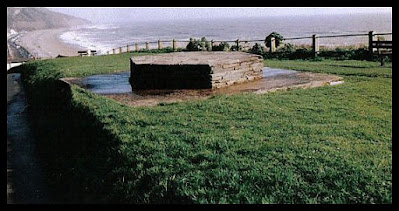All coastal towns during the second world war had defences put in place in the event of an invasion. As well as the Coastal Battery at Axmouth Harbour, which was at the start of an inland line of defensive emplacements called the Taunton Stop Line, other defence remains can be seen in Seaton along the seafront. This area was an important position because German aircraft used the Axe Valley as a flight path from France up to Bristol and the West Midlands. The Taunton Stop Line was particularly important because of the munitions base situated near Taunton, which had to be defended from land invasion as well as from the air.
A hexagonal plinth upon concrete hard standing (above) marks the place on the western cliffs where an emergency Royal Artillery Coastal Battery stood. It was camouflaged beneath a wooden construction to look like a house. Interestingly, the only bombing of Seaton occurred was of Jubilee House (now Jubilee Gardens) when a German bomber jettisoned unused shells prior to the flight back across the channel.
Further eastwards along the path I found what looks like the opening to an underground bunker. It may have been a shelter, but I think (and please don't quote me on this) that it may have been an underground armament store. My reasoning is because of its situation; near enough to supply the battery, but far enough to be out of the line of fire. It is also similar to other WW2 MOD constructions, and thin lead lining can just about be seen between the brickwork and concrete.
On the road east to the clifftop is this variant pillbox. Hardly recognisable, unless you know that it's there, it has since been converted into the end part of a roofed parking area for Cliff Castle House behind.
The embrasures have been infilled with the same kind of building material of flint and chert, but can just about be made out beneath the concrete lintels in the photos below.
Below the pillbox, and built into the cliff under the road, is a Coastal Artillery Search Light Emplacement. This would have housed a very powerful lamp to sweep the sea and beach for enemy craft in the event of a land invasion by sea.
The photos were taken at various different times. The emplacement was once open and accessible - hence the graffiti - but a metal grille door has now been added after the building was given a fresh coat of paint. Sadly, there's still the odd thoughtless person clambering in to make their mark.
It isn't until getting inside that you realise what an amazing view can be seen of the sea and coastal area.
At one time, many years ago, there were removable shutters to the front opening. A visitor to my erstwhile website kindly told me that it was used by Seaton beach lifeguards in the 1970s, which I vaguely remember, and which was a very appropriate use for such a fantastic view.
These remains (below) can be seen at low tide during the spring tides. I haven't been able to ascertain for certain whether they were parts of the WW2 beach defences or just old remains of eroded steps. However, on beaches during the war scaffolding pipes were fixed into concrete bases, the crosspieces of which were filled with bales of barbed wire...and these look as if they may have been used for that purpose.
And finally, a couple of photos of the Searchlight Emplacement with its newly decorated look and new information board attached. A particularly big thank you to all those who have worked for many years to obtain the info board, of which I had the pleasure to be asked to add one of my photos from this article.
And here it is close up with my name on the credits at the bottom.
For more information about the Taunton Stop Line and photos of the pillboxes along the Axe Valley, please see the blog post Axe Valley WW2 Defences - Taunton Stopline Part One, which can be accessed here.





















No comments:
Post a Comment